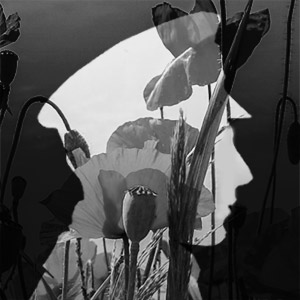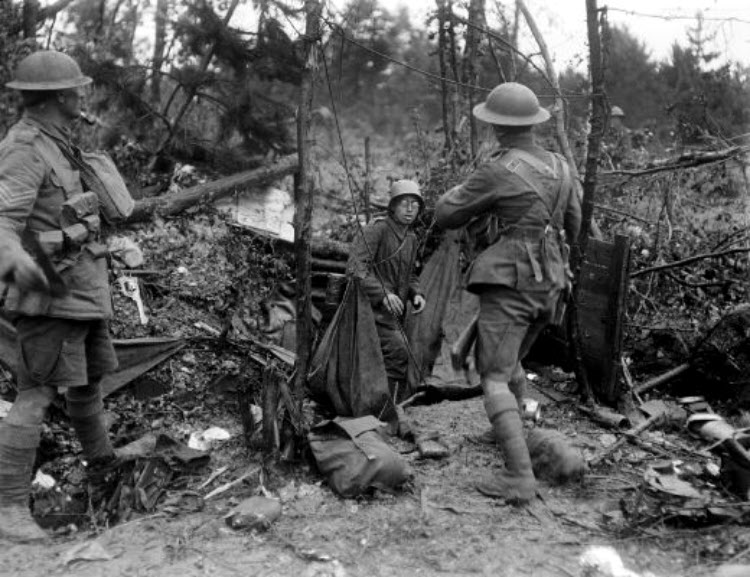
Arthur John Audsley was born in Ossett in late 1879, the eldest son of Horbury-born Nathan Audsley and his wife, Ossett-born Nancy (nee Fothergill) who married in 1863. In 1881, the Audsley family lived on Wakefield Road, Ossett and Nathan Audsley was working as an engineer/stoker. By 1891, Nathan, Nancy and four of their five children had moved to Church Street, Ossett. The family moved again in 1901, when they lived at Wilson Row, Towngate, Ossett.
On the 26th March 1904, Arthur John Audsley, of Townend, Ossett married Annie Pickersgill, of Wesley Street, at Ossett Holy Trinity Church. In 1911 Arthur John, was working as a teamer for a mungo manufacturer, and he and Annie have a 7 year-old son, Alfred Audsley. They are living in a two-roomed house at 38, Prospect Road, Ossett and sometime later they moved to live at South Parade on Ossett Low Common.
Private Audsley’s army service record has not survived but his medal card (in the name of Arthur J. Andsley) records that he was awarded the British and Victory medals, but not the 1914-15 Star, indicating that he did not serve overseas until after the 31st December 1915.
The Territorial 2nd/4th Battalion, KOYLI was formed at Wakefield on the 30th September 1914 as a second line unit. On the 1st March 1915 they moved to Bulwell and were attached to 187th Brigade in 62nd (2nd West Riding) Division. They moved in April 1915 to Strensall and in May to Beverley, going on in November to Gateshead, January 1916 to Larkhill and June 1916 to Flixton Park near Bungay. They moved again in October 1916 to Wellingborough and landed at Le Havre on 15 January 1917.
Private Arthur Audsley died at the Battle of Tardenois, during of the 2nd Battle of the Marne, which raged from July 20th to July 31st, 1918. It was called the Battle of Tardenois because of the surrounding Tardenois Plain. The 187th Brigade, 62 (West Riding) Division, to which the 2nd/4th KOYLI were attached, was heavily involved in the fighting:
“The plan was for XXII Corps to attack down the Ardre valley at 8 am on the 20th July 1918, with 51 Division on the left side of the river and 62 Division on the right. 62 Division’s start line was Pourcy to Bois de Pourcy. French and Italian artillery were to support them. Above the start line the valley was heavily wooded and difficult to penetrate, while below, it was 2 to 3 km wide with corn-fields near the river and enclosed by steep, heavily-wooded hills each side.
The attack began on time, and after a hard day’s fighting Courmas had been captured, and the XXII Corps front passed just east of Espilly, Marfaux and Cuitron, thence through the woods, west of Courmas and on to the cross-roads between Bouilly and Onrézy. Next day, 21st July 1918, attempts were made to clear the woods on the right of the 62 Division sector of enemy machine guns, so that Marfaux and Cuitron could be assaulted, but they failed with heavy casualties. That evening the XXII Corps cyclist battalion, from the New Zealand Cyclist Corps, was placed under 62 Division orders.
On the 22nd July 1918, further action was taken to clear the woods and this time was partially successful. Fighting patrols were sent against Marfaux but could not enter it. On the 23rd July 1918, the woods were finally cleared of the enemy with assistance from the French on the right, whereupon Marfaux and Cuitron were captured. During the night of 23rd to 24th July 1918, 62 Division’s HQ moved up to Hautvillers. The 24th of July was a relatively quiet day, though Marfaux and Cuitron were heavily shelled by the Germans. During the day the 62 Division front was shortened by the French on the right taking over the responsibility for the wooded upper slopes of the valley.
During the night of the 24th to the 25th July 1918, there was a very heavy German air attack on Épernay and the area as far as Châlons-en-Champagne, during which the French ammunition and petrol dumps were hit and destroyed. One account says that 62 Division’s ammunition column was attacked on the Reims to Épernay road during this raid and suffered damage.
On the 25th July 1918, a XXII Corps conference was held at which an attack was decided on for the 27th July. On the 26th July 1918, Marfaux, Cuitron and Pourcy were heavily shelled by the enemy but the front was otherwise quiet. During the day a divisional commanders’ conference was held to plan the attacks on the 27th. The main attack was to be made by 51 Division, aided by one brigade of 62 Division, transferred to the left bank of the river for that purpose, while the left flanking brigade of 62 Division was to advance and keep in touch with the right flank of 51 Division. The French would attack La Neuville and Paradis in their sector on the left of 51 Division.
During the night of the 26th to the 27th July 1918, on orders from Ludendorff, the German front was withdrawn to the line Vrigny to Ville-en-Tardenois. In the Ardre valley, this meant falling back to and holding Bligny and Montagne de Bligny. On the 27th July 1918 the planned attack took place, but, because of the overnight German withdrawal, met little opposition. In the morning Espilly and Nappes were taken, as was Chaumuzy in the afternoon. Bligny and Montagne de Bligny were reached but were strongly held by the enemy rearguards.
The same day, 62 Division HQ moved to Nanteuil, from which practically the whole of the battlefield could be seen. On the 28th July 1918, Bligny and Montagne de Bligny were captured by 62 Division, despite renewed German resistance. The 8th Battalion, West Yorkshire Regiment was awarded the French Croix de Guerre for the latter operation. During the night of the 28th to the 29th July 1918, contacts were made with the French on the right of 62Div and there was some patrolling beyond Bligny and around Montagne de Bligny. The next day, 29.7.18, there was some further fighting near Montagne de Bligny and 62 Division received notification that XXII Corps was to be pulled out for entrainment to another area. On the 30th July 1918, 62 Division was relieved by the French and retired from the line, and on the 31st July 1918, one brigade from each of 51st and 62 Division made a farewell march-past before Gen. Berthelot, commander of the French V Army. 1

Above: Battle of Tardenois. Men of the 1/5th Battalion, Devonshire Regiment (185th Brigade, 62nd Division) taking captive a German prisoner in the Bois de Reims on the 24th July 1918.
Private Arthur Audsley died on the 29th July 1918, aged 39, and he is buried at grave reference XVII A 15 in the Terlincthun British Cemetery, Wimille, 2 Pas de Calais, France. Terlincthun British Cemetery is situated on the northern outskirts of Boulogne.
The first rest camps for Commonwealth forces were established near Terlincthun in August 1914 and during the whole of the First World War, Boulogne and Wimereux housed numerous hospitals and other medical establishments.
The cemetery at Terlincthun was begun in June 1918 when the space available for service burials in the civil cemeteries of Boulogne and Wimereux was exhausted. It was used chiefly for burials from the base hospitals, but Plot IV Row C contains the graves of 46 RAF personnel killed at Marquise in September 1918 in a bombing raid by German aircraft.
In July 1920, the cemetery contained more than 3,300 burials, but for many years Terlincthun remained an ‘open’ cemetery and graves continued to be brought into it from isolated sites and other burials grounds throughout France where maintenance could not be assured.
During the Second World War, there was heavy fighting in the area in 1940. Wimille was devastated when, from 22 – 25 May, the garrison at Boulogne fought a spirited delaying action covering the withdrawal to Dunkirk. There was some fighting in Wimille again in 1944. The cemetery suffered considerable damage both from the shelling in 1940 and during the German occupation.
The cemetery now contains 4,378 Commonwealth burials of the First World War and more than 200 war graves of other nationalities, most of them German. Second World War burials number 149.
References:
1. Battle of Tardenois – The British 62nd Division in the Great War